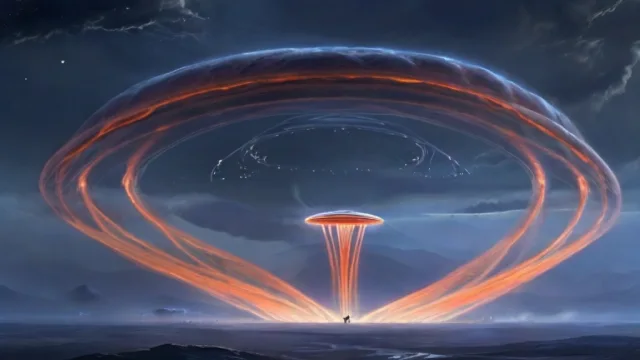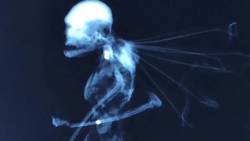Candidate of Technical Sciences,
Corresponding member of the MAI
ON THE ISSUE OF MATERIAL TRACES OF UFOs
In the mountains around g. Tuapse in 1990 samples of the substance were found, which are thin, rigid fibers of light gray color with a metallic luster. Conducted at the All-Russian Institute of Aviation Materials Science (VIAM) at the request of the UFOcenter, studies have shown that the fibers have an internal glass-like amorphous base with a diameter of (28-34) microns and an external zinc coating with a thickness of 1 to 15 microns.
The fiber base consists of silicon, calcium, sodium, magnesium additives (in descending order) and almost background amounts of aluminum and copper. All chemical elements are present in the form of oxides. The zinc coating has a cellular (crusty) structure with the main size of micrograins (apparently dendritic cells) in the range (1.7 x 2.0) microns - (8.0 x 9.0) microns.
The appearance, dimensions, and chemical composition of the fibers have not changed after holding them for 25 months. According to the conclusion of VIAM specialists, the studied the samples are of terrestrial origin and are manufactured by enterprises of the aerospace industry.

The results obtained are of no ufological interest, however , they are presented as fully as possible. The motivation for this was the speech at the fifth Siegel readings by a member of the Coordinating Council UFOS S.V. Romanov, who reported the discovery of "Veronica's hair" in the Tuapse Mountains in 1990. This term is well known to ufologists.
They denote UFO emissions in the form of filaments or filamentous formations. They are slightly radioactive, disappear quickly after reaching the surface of the bodies, and when touched with hands they cause itching and turn into an unpleasant -smelling mass, which also disappears quickly, leaving easily washed-off green spots on the hands. It was possible to partially determine the composition of the elements included in them: boron, silicon, calcium and magnesium /1-3/. According to S.V. Romanov, the samples he studied of what he defines as "Veronica's hair" are fragile glass-like hairs with a zinc-aluminum coating and a melting point from 700 to 1400 ° C / 4/.
S.V. Romanov himself does not deny that the find may have an earthly origin, but then why rush to a message that reduces the overall level of Siegel readings and ultimately causes a negative attitude of specialists in science and technology to ufological research areas.
Of particular interest, in our opinion, is the message by A.N. Deshabo published in the fourth issue of the newspaper Nedelya in 1993 under the heading "Star Wars or what?". Here are the necessary excerpts from the publication: "...I saw a flat round object of bluish color. And on the left - about the same size and exactly the same shape, only green. They approached slowly and silently, and when there were five kilometers between us....they hung motionless. Suddenly, a red ball separated from the right object and slowly floated towards its neighbor. ...The left neighbor released a white sting ray towards the approaching ball. The ball began to change color to white, more and more bright, increasing in size, there was a sound like a slap, the ball hissed and, changing its trajectory, went straight to the apiary...
The beam was almost gone immediately after the slap, the objects began to move away, each in its own direction, also slowly and majestically, until they disappeared from sight... A greenish slag -like mass, more precisely, a "flop", lay near the stump... She still kept warm, she was even hot..."

Examination of samples of this pumice-like, glassy mass by specialists VIAM and the Sevkavgeologiya association showed that its radioactivity in gamma and beta radiation does not exceed background values; after calcination at 900 ° C in air, the mass of the sample remains almost constant, it retains its shape and color. The chemical composition of the surface and internal parts of the sample is identical (Fig. 5) and includes: silicon (base), calcium, potassium, aluminum, magnesium, iron (in descending order); amounts of titanium, sulfur, phosphorus and trace amounts of nickel, vanadium, copper, lead, manganese, chromium, close to background values barium, lithium, arsenic, molybdenum, zirconium, scandium, uranium, thorium, strontium. The sample contains a large number of large (up to 4 mm in diameter) and small pores, spherical, rounded, and oblong-smoothed forms.
The location of the oblong pores indistinctly reveals an oriented texture. The glassy phase of the sample has a refractive index (1.504+0.002), contains unevenly distributed crystals, clumps and recrystallized areas.
The sample is insoluble in 25% and 50% hydrochloric and sulfuric acids, completely soluble in 48% hydrofluoric acid. When it is exposed to the palm for 1-2 minutes, in a number of cases there is a feeling of heat release, which is more noticeable when it comes into contact with the sample cleavage sites on the palm. After removal the latter retains a feeling of irritation in the palm of the hand for a certain (and for each person their own) time interval - a slight tingling or burning sensation, etc. As shown by the analysis of the literature data, the phenomenon observed A.N. Deshabo over the city of Pyatigorsk, apparently belongs to the category of cases that can be conditionally interpreted as an "information exchange" between UFO.

In /5,6/ a partial analysis of samples from the assumed is given the UFO crash site near the Uzbek city of Uchkuduk. Samples in the fresh fracture has a porous, cavernous structure resembling pumice stone. The glassy phase is an amorphous mass with a color ranging from gray-greenish-blue to black. The presence of 21 elements in the samples was established. The content of silicon is more than 50%, calcium, scandium and titanium exceeds 1%, as In addition, francium, magnesium, iron, aluminum, manganese, zinc, strontium, barium, potassium, sodium, lead, cobalt, nickel, copper, silver, zirconium, vanadium, chromium, tin are present. According to the researchers /5/, UFOs are unknown the method was burned, and the resulting fiery mass of plasma type sank to the earth's surface and gradually cooled down. It is quite obvious that the catastrophe is very similar to the phenomenon observed over the city of Pyatigorsk, there is also a certain correlation in the elemental composition of these samples. The increased silicon content in both cases may be associated with high-temperature (1500-1600 °C) by the impact of the fallen fiery mass with the formation of a melt on the soil containing silicates. Science is aware of the occurrence of such melts when meteorites fall or lightning strikes /5/. However, in these cases , damage to the earth's surface is observed with a scattering of surface material, which was not the case in either the first or second cases.
In 1974, a luminous ball was observed flying over Donetsk. The balloon was moving along the Gorlovka-Donetsk line at the speed of an airliner. After a while, the balloon stopped moving and exploded, illuminating the night sky and the area within a radius of 100-150 km. After this event , many residents of the city and mining towns began to find pieces of metal gray in color. Their friction against metal objects was accompanied by a strong spark. Until 1992 , it was not possible to carry out a documented chemical analysis of the material, and its sample was stored in the North Caucasus branch of the Ufological Association.
During storage, the sample material began to spontaneously disintegrate, forming a fine powder. The color of the powder, according to independent estimates, was determined over time as silvery, bluish-gray, greenish. The analysis carried out by specialized laboratories of Rostov-on-Don, he showed that the studied powdery substance is homogeneous, practically insoluble in water and organic solvents, soluble in dilute mineral acids, does not burn and does not collapse in flame, when calcined to 800 ° C in air, it practically does not change in mass, but changes its color from bluish-gray to red-brown (brick)..The substance has no radioactivity (background 80-120 µR/h), is not magnetic. The sample contains 60 % cerium and 30 % lanthanum in the form of lanthanum hydroxide, for iron, magnesium and manganese accounts for 8-9%, the rest falls on silicon, aluminum, titanium.
It should be noted that analysis of the wreckage found in 1976 on the river Vashka (Komi Republic) also showed the content of rare earth elements in it: lanthanum 11%, neodymium 9%, as well as zirconium, and an increased ( 140 times higher than normal) content of uranium in the absence of its decay products. The sample sparked strongly when trying to pass a hacksaw over it /1/.
The presence of zirconium, lanthanum, yttrium, and praseodymium was also detected during the study of the remains of a luminous ball that exploded in the area of the village Dalnegorsk Primorsky Krai /1/.

Some foreign sources /7-11/ also note the unusual physico-chemical composition of materials found at the sites of visually observed accidents of unidentified flying objects.
In 1989 during glaciological studies of glacial sites of the North Caucasus on the plateau located above the Chegem gorge of the "Side Ridge", UFO landing sites were marked. The area exposed to them was a strip of regular shape, 8 m wide and long 80 m . Unlike the rest of the plateau's surface, the rock samples taken from this site differed by a characteristic black layering with the party exposed to UFOs; vegetation growing on the site had a light green color and signs of depression.
In 1992, a UFO landing was recorded on the Two Sisters hill near Belaya Kalitva, Rostov region. The landing site was also marked with a black plaque on the soil surface and was a circle with a diameter of 9 m.
About author:
Serg Toporkov Ufologist, Ph.D., blogger, I go on my own expeditions for UFOs. I use scientific methods to investigate the UAP phenomenon. Write to me |
Related tags:
UFOs unidentified flying objects material traces chemical composition analysis Pyatigorsk Uchkuduk Donetsk lanthanum cerium rare earth elementsRandom UFO or conspiracy article
An X-ray image of a strange creature with wings has been published
 Numerous legends and stories tell about the amazing creatures that inhabited our planet long before the appearance of man, and could even share the Earth with our species. Dragons, elves, dwarves, fairies. Could these creatures really exist, or are these legends just a fantasy?
Numerous legends and stories tell about the amazing creatures that inhabited our planet long before the appearance of man, and could even share the Earth with our species. Dragons, elves, dwarves, fairies. Could these creatures really exist, or are these legends just a fantasy?
